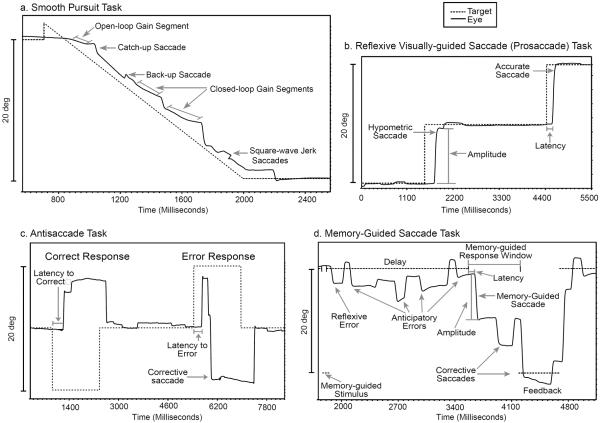Figure 1.
Examples of EMD paradigms. a. One trial of a smooth pursuit task, in which the target begins on the right side of the computer monitor and travels at a constant velocity (16 deg/s) to the left side of the monitor. Open-loop gain segment = initial period during which pursuit is initiated, typically scored for average acceleration during that period. Closed-loop gain segments = two of several segments during which the accuracy of pursuit maintenance is estimated by examining the ratio of eye velocity to target velocity. Catch-up saccade = corrective saccade that takes the eyes from a position behind the target to a position on or near the target. Back-up saccade = corrective saccade that takes the eyes from the target to a position behind the target. Square wave jerk saccades =intrusive saccades consisting of a pair of small amplitude saccades separated by a brief intersaccadic interval, preceded and followed by pursuit. b. Two trials of a visually-guided reflexive saccade (prosaccade) task, in which the participant is required simply to generate a saccade in the direction of target motion. In the first trial, the saccade generated is hypometric; the eye position amplitude falls short of target amplitude. In the second trial, the saccade is accurate; the eye position amplitude closely matches target amplitude. Latency reflects the reaction time between stimulus presentation and saccade initiation. c. Two trials of an antisaccade task, in which the participant is instructed to make a saccade in the direction opposite target motion. In the first trial, the participant correctly generates a saccade in the opposite direction of target motion. In the second trial, an inappropriate reflexive saccade error is made to the target, followed quickly by a corrective saccade in the appropriate direction. Both trials are scored for latency between target appearance and the initiation of the primary saccade. d. A memory-guided saccade task in which the participant is instructed to maintain fixation during the presentation of a peripheral stimulus (memory-guided stimulus), to continue fixation during a delay period, and upon offset of the fixation stimulus, to generate a saccade to the remembered location of the memory-guided stimulus. This participant generates an inappropriate reflexive error to the memory-guided stimulus and makes several saccades in anticipation of the fixation offset during the delay period. Upon the cue (fixation offset) to look to the remembered location, during the memory-guided response window, the participant generates an inaccurate memory-guided saccade, subsequently generating a corrective saccade landing closer to the appropriate location. At the end of the memory-guided response window, a feedback stimulus shows the appropriate location, to which the participant generates a final corrective saccade.

